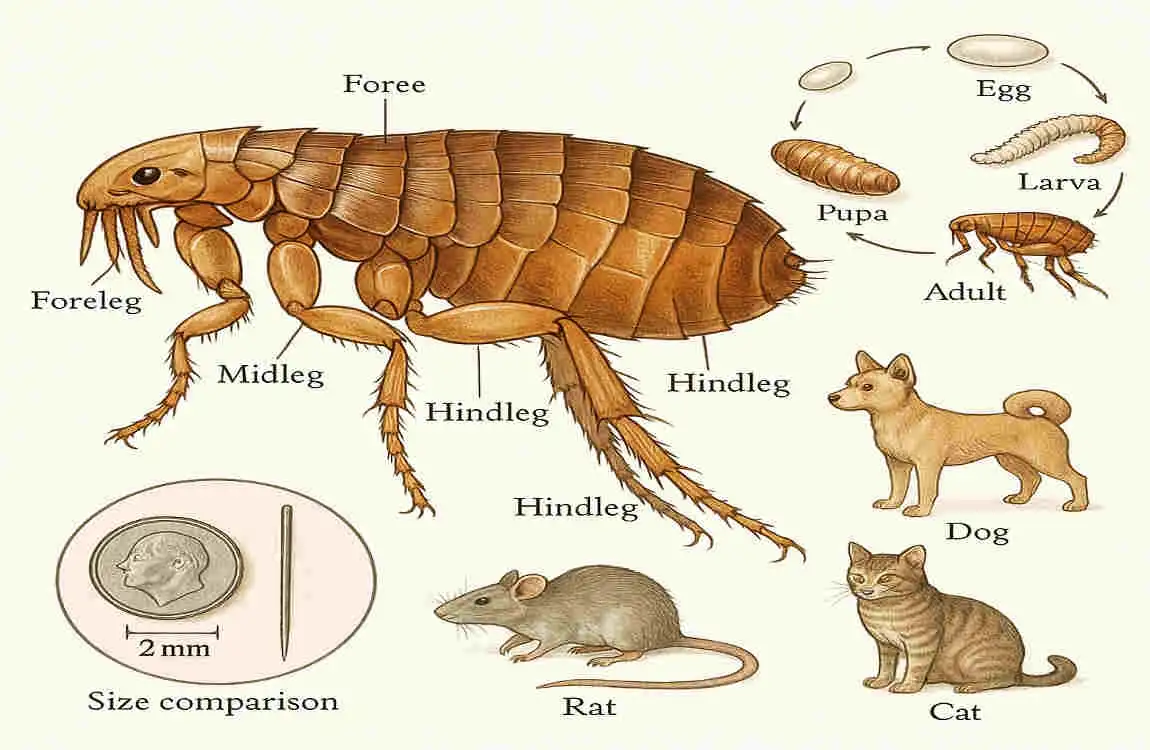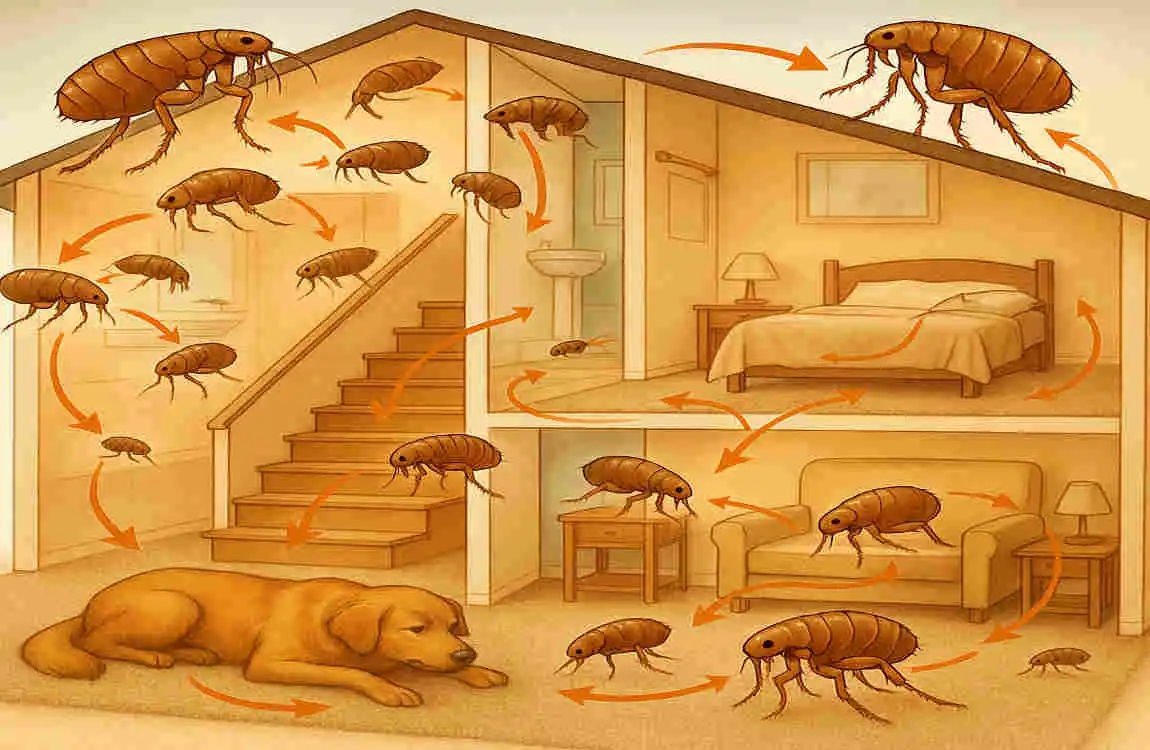Have you ever noticed a few itchy bites on your ankles and wondered how a tiny flea problem turned into a full-blown infestation overnight? If you’re dealing with fleas in your home, you’re not alone. These pesky insects can turn your cosy living space into a nightmare faster than you might think.
Understanding fleas isn’t just about getting rid of them—it’s about preventing them from taking over. By the end, you’ll have the key insights to protect your family and pets. Let’s get started and tackle this itchy issue head-on.
Understanding Fleas: The Basics

Fleas might seem like small annoyances, but they pack a big punch when it comes to invading homes. Let’s break down what makes these critters so troublesome.
What Are Fleas and Common Species in Homes
Fleas are tiny, wingless insects that thrive on blood from animals and sometimes humans. The most common type you’ll find indoors is the cat flea (Ctenocephalides felis), which doesn’t just target cats—it loves dogs, wildlife, and even you [8]. Other species, such as dog fleas or human fleas, occasionally appear, but cat fleas dominate household infestations because they’re adaptable and resilient.
Imagine a flea as a sneaky hitchhiker. They jump onto pets outdoors and ride inside, ready to set up shop. These pests are approximately 1-3 millimetres long, with flat bodies that enable them to easily slip through fur or fabric.
Flea Anatomy and Behaviour That Supports Quick Spread
What really helps fleas spread so fast? Their anatomy is built for speed and survival. Fleas have powerful hind legs that let them jump up to 18 centimetres vertically and 32 centimetres horizontally—that’s like a human leaping over a building [4]! This jumping ability allows them to hop from one host to another in seconds.
Behaviour-wise, fleas are night owls. They prefer dark, humid spots and avoid light, which is why they love hiding in carpets, under furniture, or in pet bedding. They’re also adept at survival: adult fleas can live for months without feeding if conditions are right, waiting for the perfect moment to strike [7].
Why Fleas Are Considered a Serious Pest
Don’t underestimate fleas—they’re more than just itchy. Their bites cause red, swollen spots that can lead to allergic reactions, especially in pets. Worse still, fleas transmit diseases such as tapeworms or, in rare cases, bubonic plague [2].
Think about it: one flea bite isn’t the end of the world, but when they multiply, your home becomes a breeding ground for discomfort and health risks. That’s why knowing how fast fleas spread in the house is crucial. It helps you act before things get out of control.
How Fast Do Fleas Spread in the House? The Reproductive Cycle Explained
Now, let’s get to the heart of the matter: how fast do fleas spread in the house? It all boils down to their lightning-fast life cycle. One flea can lead to thousands in just a few weeks if left unchecked.
You may also read (guide to cleaning brown stains on house mattresses).
Overview of Flea Life Stages
Fleas go through four main stages: egg, larva, pupa, and adult. This cycle is like a well-oiled machine designed for rapid population growth [1].
Eggs are tiny, white, and slippery—they fall off hosts easily and scatter everywhere. Larvae look like mini worms, feeding on organic debris. Pupae are the dormant stage, encased in cocoons. Adults emerge hungry and ready to bite.
Timeframes for Each Stage Under Ideal Indoor Conditions
Under ideal home conditions—think warm temperatures of 70-85°F and humidity above 50%—this cycle proceeds smoothly [3]. Eggs hatch in just 2-10 days. Larvae mature in 5-11 days, then pupate for approximately a week; however, they can remain dormant for months if the conditions are too cold or dry [6].
Adults live 2-3 months but start laying eggs within 24-48 hours of their first blood meal. That’s speedy! In a month, a small group can explode into a massive infestation.
Female Flea Egg-Laying Capacity
Here’s where it gets scary: a single female flea lays up to 50 eggs per day after feeding [1]. Do the math—if you have 10 females, that’s 500 eggs daily. Over a month, you’re looking at over 250,000 potential fleas!
These eggs aren’t sticky; they roll off pets and into cracks, making how fast fleas spread in the house a question of environment more than anything. Warm, humid spots accelerate this process, turning your living room into flea central.
Conditions That Accelerate Flea Reproduction
Temperature and humidity are key accelerators. Fleas love 75-85% humidity and temps above 70°F—common in many homes [4]. Shaded areas, such as under couches or in basements, provide shelter, allowing larvae to thrive undisturbed.
Reader, have you checked the humidity in your home lately? Simple things, such as leaky pipes or pet areas, can create these ideal spots, thereby accelerating the spread.
To visualise the timeline, here’s a quick table on the flea life cycle:
Stage Duration Key Activities Ideal Conditions
Egg 2-10 days Hatching from laid eggs Warm, humid environment
Larva 5-11 days Feeding on debris, growing in Dark, moist areas
Pupa 7-10 days (up to months dormant) Cocoon stage, waiting to emerge Protected spots like carpets
Adult 2-3 months Biting, laying eggs Access to blood hosts
This table shows just how quickly things escalate—perfect for understanding how quickly fleas spread in the house.
Factors That Cause Fleas to Multiply Rapidly Indoors
Your home might unknowingly be a breeding ground for fleas. Let’s explore why fleas multiply so quickly inside.
Optimal Indoor Environment for Flea Survival and Reproduction
Fleas adore the indoors because it’s stable. Carpets, rugs, and pet bedding offer warmth and humidity, shielding them from outdoor threats. Unlike outside, where the weather can be detrimental, your house provides a constant 70°F haven.
Humidity is crucial—below 50%, eggs dry out. But in a steamy bathroom or laundry room? Fleas thrive and multiply.
Flea Feeding Behaviour and Blood Meals for Egg Production
Adult fleas need blood to reproduce. Females require a meal before laying eggs, often from pets or you [8]. One bite, and she’s off to the races, producing dozens of eggs.
Without hosts, fleas starve, but even a short visit from a stray animal can kickstart an infestation. That’s how quickly things escalate.
How Pets Act as Hosts and Vehicles
Pets are flea taxis. They bring these pests inside from yards or parks, then distribute eggs as they roam [5]. A dog scratching in the living room scatters eggs into carpets, where they hatch unseen.
If you have multiple pets, the problem becomes even more complicated. One infested cat can spread fleas to every room in just a few days.
Role of Household Fabrics and Cracks as Safe Havens
Fabrics like upholstery and curtains harbour larvae, which munch on flea dirt (digested blood). Cracks in floors or baseboards can conceal pupae, making them inaccessible to vacuums.
These hiding spots explain how fast fleas spread in the house—they’re everywhere before you notice.
How Fleas Spread From One Area to Another Inside Your Home

Fleas don’t stay put; they move like pros. Understanding this helps you see the bigger picture.
Flea Jumping Ability and Rapid Movement
With jumps up to 150 times their body length, fleas hop between pets, furniture, and people effortlessly [4]. From the bedroom to the kitchen in seconds—that’s mobility!
Humans unwittingly contribute to the spread by carrying fleas on their clothes, which they then spread from room to room.
How Eggs Fall Off Pets and Scatter
Eggs aren’t glued on; they tumble off as pets move. A quick shake in the hallway means eggs in the carpet, ready to hatch.
This scattering turns localised problems into house-wide issues fast.
The Challenge of Flea Pupae Dormancy
Pupae can wait months in cocoons, emerging when vibrations signal a host nearby—like you walking by [6]. This dormancy tricks you into thinking fleas are gone, only for them to resurface.
It’s a sneaky tactic that delays detection.
Impact of Human and Pet Movement
Every time you or your pet walks around, you’re helping to spread it. Fleas hitch rides, eggs drop, and suddenly, the basement has fleas too.
Reader, think about your daily routine—how many rooms do you visit? That’s potential flea highways.
Signs and Symptoms of a Fast-Spreading Flea Infestation in Your Home
Spotting fleas early is key, but they can spread so quickly that signs can escalate overnight.
Behavioural Signs in Pets
Watch your pets: excessive scratching, biting at fur, or hair loss screams fleas. Restless behaviour or “hot spots” from allergies are red flags.
If your dog is more fidgety than usual, investigate—fleas might be multiplying.
Visible Signs in the Environment
Look for flea dirt—black specks like pepper that turn red when wet (it’s dried blood). Tiny white eggs or jumping adults on the floor are obvious.
Human bites, especially around the ankles, indicate a potential risk of spreading to others.
How Quickly a Light Infestation Becomes Severe
A few fleas can multiply into hundreds in just weeks if left untreated. Eggs hatch, larvae grow, and boom—severe infestation.
How fast do fleas spread in the house? From mild to major in under a month without action.
Why Flea Populations Explode Before Detection
Dormant pupae hide the true numbers. You kill adults, but new ones emerge, making it seem like endless waves.
Early signs are subtle, so populations boom undetected.
Here’s a quick list of early warning signs to watch for:
- Pets are scratching more than usual.
- Small red bites on your skin, often in clusters.
- Black specks (flea dirt) on bedding or floors.
- Jumping insects near pet areas.
Effective Steps to Control and Prevent Flea Infestations
Don’t panic— you can fight back. Let’s talk actionable steps.
You may also read (how do home gardens contribute to environmental health).
Importance of Early Intervention
Act fast once you spot signs. Delaying allows the cycle to continue, thereby worsening the rate at which fleas spread in the house.
Early treatment breaks the chain before numbers skyrocket.
Treating Pets with Veterinary-Approved Products
Start with pets: use flea shampoos, collars, or spot-on treatments recommended by your veterinarian [2]. These kill adults and prevent egg-laying.
Regular check-ups ensure your furry friends stay flea-free.
Regular Thorough Cleaning
Vacuum daily— it sucks up eggs, larvae, and adults from carpets. Wash bedding in hot water weekly, and steam clean furniture as needed.
Focus on crevices; that’s where they hide.
Environmental Treatments
For the house, try insecticides, diatomaceous earth, or boric acid [4]. These target all stages safely.
Apply carefully, following instructions to avoid harm.
Preventive Measures
Limit pet access to infested yards, mow grass short, and check for wildlife [6]. Use flea preventatives year-round.
Reader, what’s your prevention routine? Simple habits can keep fleas at bay.
Another list for prevention tips:
- Treat pets monthly with flea meds.
- Vacuum high-traffic areas frequently.
- Seal cracks in floors and walls.
- Monitor for strays or wildlife near your home.
Common Misconceptions About Flea Spread and Control
Myths can make flea problems worse. Let’s debunk a few.
Misunderstanding Flea Dormancy
People think empty homes are flea-free, but dormant pupae can survive months without hosts [7]. You return from vacation, and suddenly—fleas!
That’s why thorough cleaning matters even in vacant spaces.
Beliefs About Flea Movement
Fleas don’t just jump from pet to pet; they also use humans and objects [5]. Assuming only pets spread them ignores the full picture.
Why Killing Adults Alone Isn’t Enough
Spraying adults feels good, but eggs and larvae survive [1]. You need to target all stages for real control.
This misconception explains recurring infestations—don’t fall for it.
Professional Flea Control: When and Why to Seek Help
Sometimes, DIY isn’t enough. Know when to call pros.
Cases When Home Treatments Fail
Heavy infestations or resistant fleas overwhelm home efforts [9]. If you’ve tried everything and fleas persist, it’s time.
Professionals handle what you can’t see.
Benefits of Professional Inspection and Services
Experts inspect thoroughly, identifying hidden spots [3]. They use safe, effective treatments that last.
Plus, they save you time and frustration.
How Professionals Approach Flea Problems
They employ integrated pest management, which combines treatments, prevention, and monitoring [6]. It’s holistic, addressing the roots, not just the symptoms.
You may also read (diy guide cleaning moss from your house roof).

